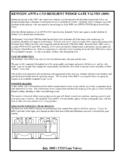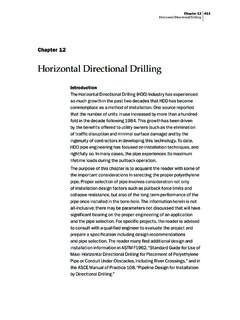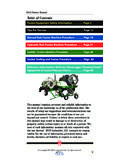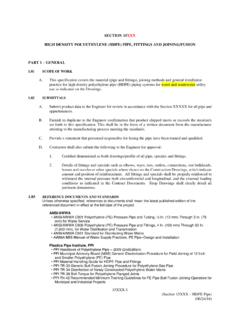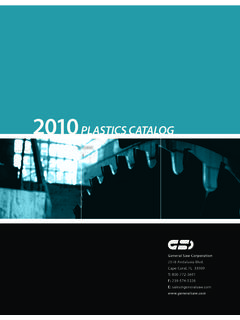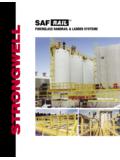Transcription of WL Plastics PE3408 HDPE Pipe – Determining …
1 PRESSURE RATING. WL Plastics HDPE Pressure pipe Internal Pressure Rating Determining Pressure Ratings for The equations below are used to determine a long-term Applications internal pressure rating by taking into account the material's long-term strength, operating temperature, environmental (application) conditions and pipe size. Short-Term and Long-Term Performance WL Plastics pressure rated HDPE pipe is manufactured 2 HDS fT f E. PR = (1). from polyethylene materials that are custom engineered to (DR 1). provide the unique properties needed for pressure pipe . Where Pipes must withstand short-term and long-term loads from the application, and here polyethylene is unique because PR = pressure rating, psi. its strength under load depends on the magnitude of the HDS = hydrostatic design stress at 73 F, psi load and how long the load is applied. fT = operating temperature multiplier Under short-term loads, polyethylene typically reacts in a fE = environmental design factor resilient, ductile-elastic manner, but the reaction to long- DR = pipe dimension ratio term loads is very different.
2 Short-term ultimate strength D. is characterized by tremendous ductile elongation DR = (2). t (necking down and stretching) and then failure in the elongated area. In contrast, long-term ultimate strength is D = pipe outside diameter, in characterized by cracks that grow slowly through the pipe t = pipe minimum wall thickness, in wall (slow crack growth). Short-term and long-term Polyethylene material strength is inversely dependent on characteristics are so different that short-term properties temperature, that is, its strength decreases at elevated cannot be used to predict long-term performance. temperatures. Eq. 1 relates strength to temperature using Polyethylene pressure pipes are designed for years of a Table 2 operating temperature multiplier, fT. When continuous internal pressure. To predict (rate) long-term Determining an application pressure rating, the fT for the internal pressure performance, polyethylene pipe highest application operating temperature is typically used materials must undergo long-term testing and analysis to for a conservative rating.
3 Determine the internal pressure the pipe can withstand at Table 2 Operating Temperature Multiplier, fT. an operating temperature. For polyethylene pressure pipe Maximum Operating materials, testing and analysis is conducted in accordance Temperature Multiplier, fT. with ASTM and PPI standards 1 . PE3608. The hydrostatic design stress, HDS, is a maximum long- F C PE4710. PE3408 . term design stress at an operating temperature for the 40* 4 material. For polyethylene pressure pipe materials, the >40 60* >4 16 HDS is typically determined at 73 F and 140 F. Table 1 >60 80 <16 27 shows HDS ratings for WL Plastics HDPE materials. >80 90 >27 32 Table 1 HDS WL Plastics HDPE >90 100 >32 38 >100 110 >38 43 HDS at 73 F HDS at 140 F. >110 120 >43 49 PE4710 1000 psi 630 psi >120 130 >49 54 PE3608/ PE3408 800 psi 400 psi >130 140 >54 60 * Multipliers based on midrange temperature. For water distribution and transmission applications, multipliers for 60 F (16 C) and lower temperatures are not used.
4 1. The application environment within and outside the pipe ASTM D1598 Time-to-Failure of Plastic pipe Under Constant Internal is factored into Eq. 1 using a Table 3 environmental Pressure; ASTM D2837 Obtaining Hydrostatic Design Basis for Thermoplastic pipe Materials; PPI TR-3 Policies and Procedures for design factor, fE. Developing Hydrostatic Design Basis (HDB), Pressure Design Basis (PDB), Strength Design Basis (SDB), and Minimum Required Strength (MRS) Ratings for Thermoplastic Piping Materials or pipe WL118-0308 Rev Mar 2008 Supersedes all previous editions. 2008 WL Plastics Corp. Pg. 1 of 4. Table 3 Environmental Design Factor, fE 2 (800 )( )( ). PR 125 psi or = 128 psi Factor, fE Environmental and Applications Conditions, (9 1). Liquids that are chemically benign to polyethylene The calculation yields 128 psi, but US Federal such as potable and process water, municipal Regulations limit the pressure rating to 125 psi for 12.
5 Sewage, wastewater, reclaimed water, salt water, brine solutions, glycol/antifreeze solutions, IPS and smaller pipes (100 psi max for >12 IPS. alcohol; Buried pipes for gases that are chemically through 24 IPS.). benign to polyethylene such as dry natural gas (in 4. Determine the long-term pressure rating for DR 11 WL. Class 1 locations where and Canadian Plastics HDPE pipe on the surface transporting Federal Regulations 2 do not limit pressure), compressed air at 120 F. methane, propane, butane, carbon dioxide, hydrogen sulfide. Per Table 3, this application is not recommended. Buried pipes for compressed air, oxygen, and other oxidizing gases at ambient temperature Liquid Flows ( 80 F/ 27 C); Only Buried pipes for fuel gases such as natural gas, LP gas, propane, Short term internal pressure surges such as water butane in gas distribution systems and Class 2, 3 hammer result from instantaneous liquid flow velocity or 4 locations where Federal Regulations changes.
6 These conditions are accommodated above the limit pipe pressure to the lesser of 125 psi for 12- long-term internal pressure rating by short-term physical in or 100 psi for >12-in. or the design pressure capabilities. rating. For distribution and transmission of liquids such as water Canada Only Buried pipes for fuel gases such or water-borne slurries, the standard surge pressure as natural gas, LP gas, propane, butane in allowance above the long-term design pressure rating is: distribution systems subject to Canadian Federal and Provincial Regulations. PSA = PR (3). Permeating or solvating liquids in the pipe or the surrounding soil such as gasoline, fuel oil, Surge pressures typically result from instantaneous liquid velocity changes from conditions such as firefighting, kerosene, crude oil, diesel fuel, liquid hydrocarbon fuels, vegetable and mineral oils. slurry blockage or component failure.
7 Liquid flow velocity is determined using pipe size is factored into Eq. 1 through the dimension ratio, DR, Eq. 2. For a given DR, wall thickness increases Q. V = (4). or decreases in direct proportion to the outside diameter. Di 2. DR is convenient because it remains constant as pipe size varies. That is, a 2 DR 11 pipe and a 24 DR 11 pipe Where have the same pressure rating for the same application V = velocity, ft/sec. temperature and environment. A side benefit is that Q = flow quantity, gal/min minimum wall thickness is easily determined by dividing Di = pipe average inside diameter, in the pipe diameter by the DR. D. Di = D (5). Internal Pressure Rating Examples DR. 1. Determine the long-term pressure rating for DR 11 WL (Note Di is an average pipe ID for flow estimation Plastics PE4710 HDPE pipe transporting brine water purposes only. Actual pipe ID will vary depending on at 125 F.)
8 Specification dimensions and tolerances. Consult 2 (1000 )( )( ) specifications or measure actual pipe ID for devices such PR = = 140 psi as stiffeners that install in the pipe bore.). (11 1). When a surge pressure event such as water hammer 2. Determine the long-term pressure rating for DR 17 WL occurs in a pipe , the velocity of the pressure surge is Plastics PE3608/ PE3408 HDPE pipe transporting dependent on the instantaneous elastic modulus of the crude oil at 115 F. pipe material and pipe dimensions. 2 (800 )( )( ) 4660. PR = = psi a=. (17 1) k Di (6). 3. Determine the long-term pressure rating for 8 IPS DR 1+. Et 9 WL Plastics PE3608/ PE3408 HDPE pipe carrying 70 F natural gas in a US Class 3 location. Where a = pressure wave velocity, ft/sec 2. k = fluid bulk modulus, psi Department of Transportation Title 49 Code of Federal Regulations Part 192; Canada CSA Z662 Clause 13.
9 = 300,000 psi for water WL118-0308 Rev Mar 2008 Supersedes all previous editions. 2008 WL Plastics Corp. Pg. 2 of 4. E = instantaneous dynamic elastic vacuum will attempt to flatten the pipe . Freestanding non- modulus of pipe material, psi pressure pipe in surface, sliplining, submerged and like = 150,000 psi for HDPE per AWWA M55 applications is not supported by embedment or other The surge pressure, PS, caused by a sudden change in external confinement that can significantly enhance liquid flow velocity is: resistance to flattening from external pressure. The resistance of freestanding pipe to flattening from external a ( v ). PS = (7) pressure depends on wall thickness ( pipe DR), elastic properties (time and temperature dependent elastic Where modulus and Poisson's ratio), and roundness. 3. PS = surge pressure, psi 2 E fO 1 . PCR = (9). v g =. =. sudden velocity change, ft/sec gravitational acceleration.
10 Ft/sec2. ( ). 1 2 DR 1 . = ft/sec2 Where (Note The sudden velocity change, v, must occur PCR = flattening resistance limit, psi within the critical time, 2L/a, where L' is the pipe length in E = modulus of elasticity, psi feet and a' is the pressure wave velocity (Eq. 6). A surge = Poisson's Ratio pressure does not occur if the time required for the = for short-term stress velocity change exceeds the critical time.) = for long-term stress During steady pressure operation, the maximum operating fO = roundness factor pressure, MOP, should not exceed the long-term pressure DR = pipe dimension ratio, (Eq. 2). rating, and during a pressure surge event, the total PCR. internal pressure should not exceed the long-term PAL = (10). N. pressure rating plus the pressure surge allowance. Table 4 shows the approximate instantaneous water velocity Where change to produce a surge pressure equal to the surge PAL = safe external pressure, psi pressure allowance.


